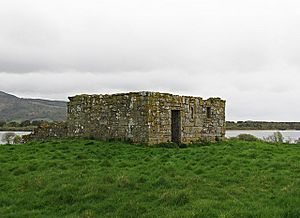St Serf's Inch Priory facts for kids
The St Serf's Inch Priory (also known as Portmoak Priory) was a special religious community. It was home to Augustinian monks called canons. This priory was first built on St Serf's Inch, a small island in Loch Leven, Perth and Kinross, Scotland.
Contents
History of the Priory
Early Beginnings
This site is one of the oldest Christian places in Scotland. A church was first built here in the year 838.
Becoming an Augustinian Priory
In 1150, King David I of Scotland decided to change the church. He made it an Augustinian Priory. This new priory was connected to the St Andrews Cathedral Priory. Before this, there was an old Scottish group of monks called Céli Dé (or Culdee) living there. People believe this group was started by Bruide, son of Dargart, a King of the Picts from 696 to 706.
The priory was likely named after St Serf (also called Servanus). The old Scottish monks had many writings, but most of them are now lost or were translated into Latin. When the Augustinian priory began in 1150, the Scottish monks could join the new group. If they did not want to join, they had to leave.
Famous Prior and New Name
One of the most famous leaders, or "priors," of St Serf's Inch was Andrew de Wyntoun. He was a chronicler, meaning he wrote down historical events. He probably wrote his book, Orygynale Cronykil of Scotland, while living on Loch Leven.
Later, in the 1400s, people started calling the priory "Portmoak". This might mean that the monks had partly moved from the island to the nearby area of Portmoak. After more than 400 years as an Augustinian monastery, the last prior left. The Protestant king, James VI of Scotland, then gave the priory to St Leonard's College in St Andrews. Over time, the old priory building was even used as a fishing hut or a small shelter called a bothy.
Exploring the Past: Archaeological Digs
Historic Environment Scotland tells us that the first archaeological digs happened in 1877.
Discoveries from Excavations
More recently, in 2011, 2012, and 2017, archaeologists did more digs at the site. They found parts of a church from the 1100s. This church was about 27 feet long and 9.25 feet wide. Its walls were 2.5 feet thick. There was an archway at each end of the church. The archway on the east side led to a rectangular area called a chancel. The archway on the west side led to a tower or the main part of the church, called a nave.
West of the church, they found the foundations of a very large building. It measured about 83 feet long and 22 feet wide. Its walls were over 5 feet thick!
Burials and Ancient Structures
Archaeologists also found burials inside the chancel. More burials were found to the south and west of the main structure. One important person buried here was Patrick Graham (archbishop).
In 2011, the team found that the site had a series of large, oval-shaped areas. These circles were centered around the chapel. The biggest one was 200 by 110 meters. Experts believe this was the vallum (wall) or sanctuary of the monastery from the 700s. They also found signs of old roads, small workshops, or living areas inside the monastery.
Artifacts and Other Features
Two areas that were dug up gave them many interesting things. They found pieces of medieval pottery and rusty iron nails. They also found a possible knife blade and small pieces of copper-alloy artifacts. A possible ceramic crucible (a pot for melting things) was also found. Amazingly, they even found a Neolithic (Stone Age) flint arrowhead!
The digs also showed an outer ditch and layers of organic material. This suggests there might have been a fish pond nearby. Small mounds to the south and east of the priory are thought to be the remains of small buildings made of turf. There were also parts of kilns used for drying corn. Radiocarbon dating showed that the ditch was made in the 1100s. Today, the site is protected as a scheduled monument, which means it's an important historical place.
See also


